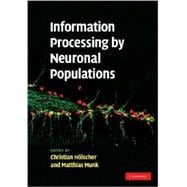
Note: Supplemental materials are not guaranteed with Rental or Used book purchases.
Purchase Benefits
What is included with this book?
| List of contributors | p. x |
| Introduction | p. 1 |
| How could populations of neurons encode information? | p. 3 |
| Organization of neuronal activity in neuronal populations | p. 19 |
| Cellular mechanisms underlying network synchrony in the medial temporal lobe | p. 21 |
| Cell assemblies and serial computation in neural circuits | p. 49 |
| Neural population recording in behaving animals: constituents of a neural code for behavioral decisions | p. 74 |
| Measuring distributed properties of neural representations beyond the decoding of local variables: implications for cognition | p. 95 |
| Single-neuron and ensemble contributions to decoding simultaneously recorded spike trains | p. 120 |
| Neuronal population information coding and plasticity in specific brain areas | p. 149 |
| Functional roles of theta and gamma oscillations in the association and dissociation of neuronal networks in primates and rodents | p. 151 |
| Theta rhythm and bidirectional plasticity in the hippocampus | p. 174 |
| Distributed population codes in sensory and memory representations of the neocortex | p. 192 |
| The role of neuronal populations in auditory cortex for category learning | p. 224 |
| The construction of olfactory representations | p. 247 |
| Functional integration of different brain areas in information processing and plasticity | p. 281 |
| Anatomical, physiological, and pharmacological properties underlying hippocampal sensorimotor integration | p. 283 |
| A face in the crowd: which groups of neurons process face stimuli, and how do they interact? | p. 326 |
| Using spikes and local field potentials to reveal computational networks in monkey cortex | p. 350 |
| Cortical gamma-band activity during auditory processing: evidence from human magnetoencephalogrphy studies | p. 363 |
| Disturbances of population activity as the basis of schizophrenia | p. 385 |
| Neural coordination and psychotic disorganization | p. 387 |
| The role of synchronous gamma-band activity in schizophrenia | p. 409 |
| Summary, conclusion, and future targets | p. 433 |
| Summary of chapters, conclusion, and future targets | p. 433 |
| Index | p. 470 |
| Table of Contents provided by Ingram. All Rights Reserved. |
The New copy of this book will include any supplemental materials advertised. Please check the title of the book to determine if it should include any access cards, study guides, lab manuals, CDs, etc.
The Used, Rental and eBook copies of this book are not guaranteed to include any supplemental materials. Typically, only the book itself is included. This is true even if the title states it includes any access cards, study guides, lab manuals, CDs, etc.